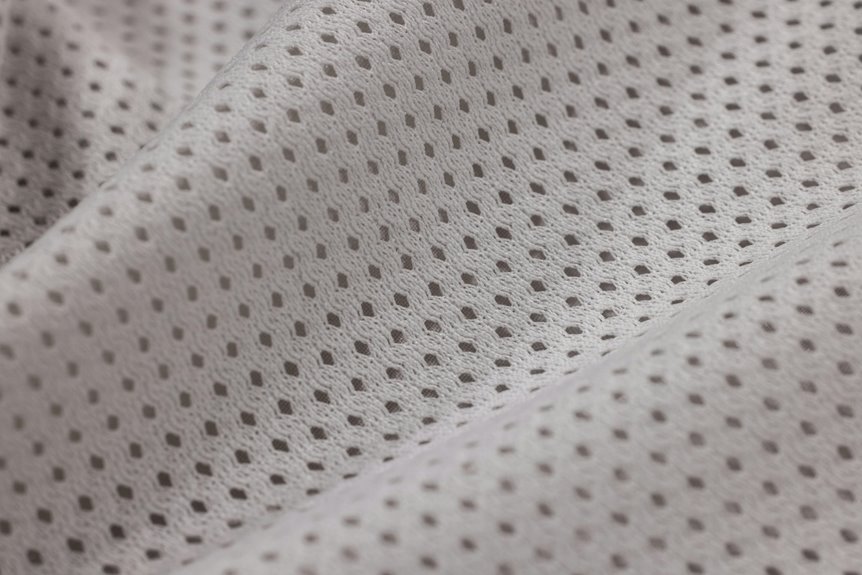Did you know that cotton fabrics absorb up to 27 times their weight in moisture? You might think that makes 100% cotton the most breathable option out there, but that’s not always the case. Depending on how the fabric is woven or the environment you’re in, other materials could offer better airflow and comfort. Let’s explore why cotton’s breathability isn’t as straightforward as it seems.
Table of Contents
Key Takeaways
- 100% cotton is breathable but not always the best choice due to fabric weave, weight, and finish affecting airflow and comfort.
- Alternatives like linen and bamboo often provide superior breathability and moisture management in hot or humid conditions.
- Cotton absorbs moisture well but dries slower, which can cause discomfort in high-intensity or humid environments.
- Synthetic fabrics and blends typically dry faster and wick moisture better, enhancing comfort during intense physical activity.
- Fabric construction and environmental factors influence breathability more than fiber content alone, so context matters in fabric selection.
Understanding Breathability Beyond Fiber Content
Although many assume that fiber content alone determines breathability, you should know that factors like fabric weave, weight, and finish play essential roles in how well a material allows air to pass through.
When you choose clothing, it’s important to take into account fabric blends since mixing fibers can change airflow and moisture management. For example, a tight weave in cotton might reduce breathability compared to a looser weave in a cotton-polyester blend.
Additionally, weather conditions influence how breathable fabric feels—humid environments demand materials that wick moisture and dry quickly, not just pure cotton.
Comparing Cotton With Other Natural and Synthetic Fabrics
Now that you understand how factors beyond fiber content affect breathability, it’s helpful to see how cotton stacks up against other natural and synthetic fabrics.
Cotton alternatives like linen and bamboo often offer comparable or better breathability, thanks to their natural fiber structures.
Linen and bamboo provide breathability equal to or surpassing cotton due to their unique natural fibers.
Synthetic fabrics, such as polyester, usually trap heat and moisture, making them less breathable, though advanced fabric blends can improve airflow and moisture-wicking.
Fabric blends combining cotton with synthetics can strike a balance, enhancing durability and moisture management while maintaining comfort.
When choosing your clothing, consider these cotton alternatives and fabric blends based on your activity and climate.
You’ll find that pure cotton isn’t always the most breathable option, especially when other factors like fabric treatment and blend ratios come into play.
The Role of Fabric Construction in Airflow and Comfort
Because fabric construction shapes how air moves through fibers, it plays an essential role in your comfort and breathability.
When you choose cotton, understanding fabric density and weave patterns helps you pick the right garment. Here’s what matters:
- Fabric Density: Lower density means more space between threads, boosting airflow.
- Weave Patterns: Loose weaves like plain or open weaves enhance breathability, while tighter weaves restrict air.
- Thread Thickness: Thinner threads create lighter fabrics that let air pass easily.
- Surface Texture: Smooth fabrics allow air to flow freely, reducing heat buildup.
Moisture Management: Cotton’s Strengths and Limitations
When you wear cotton, its ability to absorb moisture can keep you feeling dry at first, but it doesn’t always dry quickly.
Cotton excels at moisture retention, soaking up sweat and preventing it from pooling on your skin. However, the fabric’s drying speed is relatively slow compared to synthetic materials. This means that once cotton gets wet, it can stay damp longer, which might leave you feeling clammy or uncomfortable over time.
If you’re active or in humid conditions, this limitation becomes more noticeable. While cotton’s natural fibers promote breathability, its moisture management isn’t perfect.
Understanding these strengths and limitations helps you decide when cotton works best and when faster-drying fabrics might serve you better.
Choosing the Right Fabric for Different Activities and Environments
Selecting the right fabric can make a big difference in your comfort and performance during various activities and weather conditions.
When choosing activewear materials, consider these factors:
- Intensity of Activity: For high-intensity workouts, moisture-wicking synthetics outperform cotton by keeping you dry.
- Weather Conditions: Opt for breathable cotton in mild weather; switch to lightweight synthetics or blends in hot, humid climates.
- Layering Needs: Use cotton for base layers in cool weather, but rely on technical fabrics for insulation and moisture control.
- Durability and Care: Synthetic activewear materials often dry faster and resist wear better than 100% cotton, ideal for frequent use.
Frequently Asked Questions
How Does Organic Cotton Impact Breathability Compared to Conventional Cotton?
You’ll find organic cotton benefits include better breathability due to fewer chemicals used, which lets your skin breathe easier. Conventional cotton drawbacks like pesticide residues can reduce airflow, so organic cotton often feels fresher and more comfortable.
Can Cotton Fabrics Be Treated to Improve Moisture-Wicking Properties?
You can enhance cotton fabric technology with moisture-wicking treatments, making cotton fabrics better at drawing sweat away. These treatments improve comfort during workouts or hot days, so you don’t have to rely solely on natural breathability.
What Is the Environmental Footprint of Cotton Versus Recycled Cotton?
You’ll find cotton production uses lots of water and pesticides, raising its environmental footprint. Using recycled materials cuts resource use and waste, making recycled cotton a greener, more sustainable choice for your eco-conscious wardrobe.
How Does Cotton Fabric Durability Affect Breathability Over Time?
You’ll notice fabric longevity impacts cotton’s air permeability; as the fibers wear down, breathability can improve but durability decreases. So, over time, your cotton clothes might feel airier but won’t last as long.
Are There Specific Cotton Blends That Enhance Breathability Without Losing Comfort?
Coincidentally, you’ll find cotton blends often mix breathable fabrics like linen or polyester, boosting airflow without sacrificing comfort. So, you can enjoy enhanced breathability and softness, especially in active or hot weather situations.







